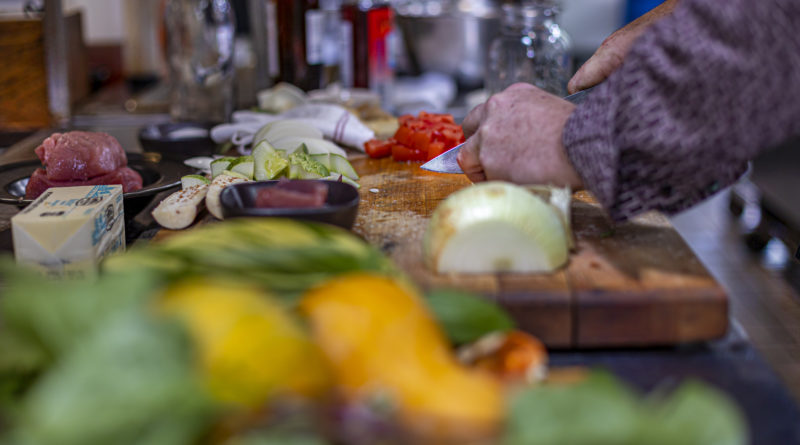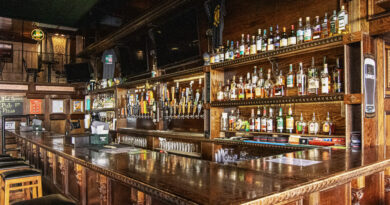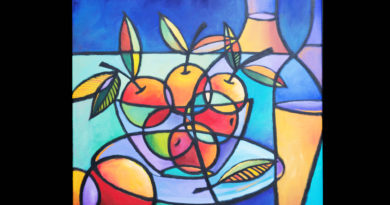Southern decadence, retro cool & international flair at the Barton House Restaurant in Salado
By Janna Zepp | Photos by Skeebo, Janna Zepp and courtesy of Barton House
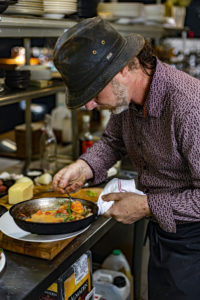
Standing in the midst of the Barton House herb and vegetable garden on a sultry, late summer morning in Salado, Barton House Owner Clinton Harwell and Executive Chef Jacob Hilbert discuss potential menu items for the restaurant. Hilbert pinches a piece of this and a bit of that, telling Harwell how each will alter or enhance the flavors of the meals and attendant cocktails created and planned for the week by the clever mixologist talents of Barton House Director of Operations Amanda Eakin.
“The season is gradually moving from summer to autumn, and the change is already visible in the vegetables and herbs. You can see it in our garden,” Hilbert says, handing Harwell a picking. Harwell wants to respond but is drowned out by the ear-splitting cry of one of the restaurant’s peacocks.
“We have some birds,” Harwell says, grinning. “They’re not on the menu, of course.”
The peacocks are the inspiration for the Barton House’ logo, two gold peacock feather eyes intertwined on a black canvas. Peacock imagery pops up in unexpected places in the restaurant, from menus to brass bill presenters. It is ever-present without being obvious and is a nod to the elegant atmosphere and décor of the 1850s-era house in which the restaurant operates.
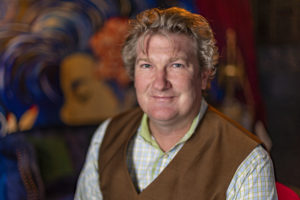
The eatery has an air of Southern, slightly avant-garde-old-money casual opulence that makes you want to dress for dinner just a little bit more than you might normally do when spending an evening at a restaurant. Here, dinner is an event as much as it is a meal. It’s not just chef-prepared cuisine; it is performance art, especially on World Tour Wednesday nights, during which the food of different, exotic nations are showcased as a once-a-week dining event that introduces Central Texans to many countries most have never even heard of.
And yes, there’s a dress code, but it is not terribly restrictive. Their website at www.thebartonhousesalado.com definitively describes it. Intimidated? Don’t be. Just look nice enough to go to church on Sunday, and you should be just fine.
The Barton House was not always this upscale, although it was certainly a cut above many restaurants in atmosphere and menu. It began, under Harwell’s ownership, as a family-friendly, yet trendy restaurant with an Italian/Southwestern fusion menu. And then his girlfriend asked to redecorate one of the rooms in the restaurant.
“Suddenly, we had this gorgeous dining area that did not match with the rest of the restaurant,” he says. “So we shut down, redecorated some more, and revamped the entire concept, complete with bringing Jacob on board.”
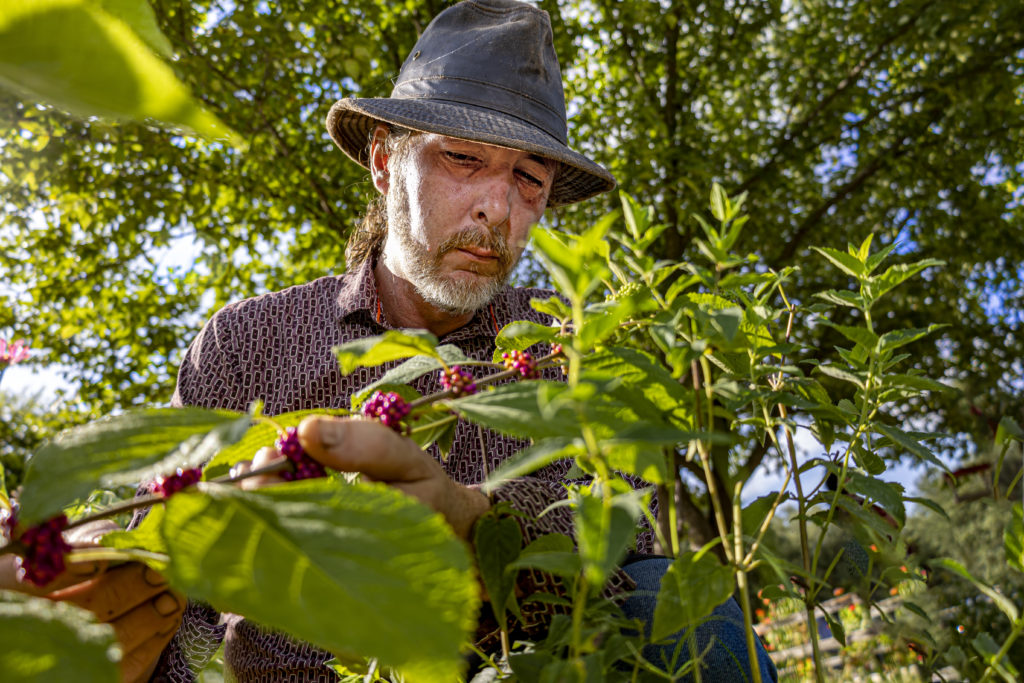
Hilbert’s approach to food is fascinating, combining not just the chemistry of cooking, but also the biology, geology, culinary history and local culture to his work. Originally from North Carolina, he draws a lot from the recipes of the American South. During the interview, he sports a T-shirt that has images of mushrooms on it and reads: “A Mycologist With Questionable Morels”; a nod to his passion for cooking with mushrooms.
“Mushrooms can greatly enhance whatever you are cooking them with. I love working with lobster mushrooms. They get parisitized by another fungus, called Hypomyces. The Hypomyces fungus seems to infect areas where Russula and Lactarius mushrooms grow. That makes them contort into weird shapes. The funny part is that the transformation makes the mushrooms taste better than they would before. They only have a slight flavor and aroma of fresh lobster and that intensifies when they’re dried,” Hilbert says as he shows off the edible, crustacean-like fungus.
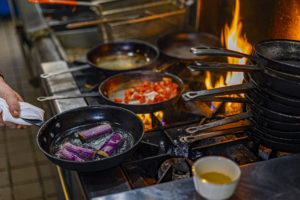 At this point in the conversation, it is difficult to distinguish chef from biologist. And then the topic switches to genealogy.
At this point in the conversation, it is difficult to distinguish chef from biologist. And then the topic switches to genealogy.
“My great-grandmother was incredibly talented in the kitchen and her food was always really good,” he says. “We forget that a lot of what we eat was also eaten by our ancestors and I love grow things that most people don’t eat anymore, but once did when we were more of an agrarian society. I love to cook things that my ancestors — our ancestors — would have eaten and did eat a hundred years ago.”
The discussion drifts to history, specifically food being prepared in the Middle Ages on a hearth or over an open fire. When asked if he thought there might be just a bit of alchemy or magic in the process of preparing meals, he nods.
“I have cookbooks with recipes from the medieval period in them that are full of wonderful dishes. I love researching what people ate 800 years ago. I never know what I might find that is useful in what I do in the kitchen,” Hilbert replies. “It’s part of why we have the garden. The herbs used in ancient cooking are still excellent in food today.”
You can also taste that herbal magic in the cocktails created by Eakin. When you chat with her at your table, she admits that the old school, classic cocktails such as gin rickeys and sidecars are her favorite kind to make. She also loves to put her own spin on some classics to update it for the modern palate. The most recent cocktail on the menu at this writing is the Dairy Farm, which is garnished with a fragrant bouquet of herbs from the Barton House garden. It has no milk in it but has a creamy texture and soft flavor that is as smooth and pleasant as heavy cream.
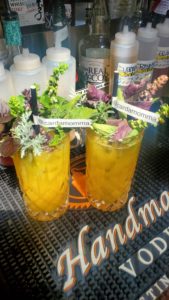
Those cocktails pair well with the Barton House’s Sirena Speakeasy in the basement.
Pull back a small bookcase in the restaurant’s entryway, not far from the host station, and you’ll see a staircase leading downstairs. Watch your head on the way down; you’re walking beneath the staircase leading up to a private dining space. It’s a little bit tight for tall people.
Once there, you’ll discover a dark, cozy, plush series of quiet and intimate sitting areas with early 20th century art and images on the walls, a little Post-Modern jukebox music (popular songs re-recorded into jazz, ragtime, or lounge tune styles from the early and mid-20th century) playing throughout, and lockers in which Speakeasy club members store their own libations ordered especially for them by Eakin on request.
Membership includes, but is not limited to, discounts on wine purchases and special events. Hint: this is a date-night destination after dinner.
Word to the wise: make reservations to dine at the Barton House about a week in advance on your Open Table phone app. Space fills up quickly and seating is limited, especially on those World Tour Wednesday nights. Chef Jacob also hosts cooking classes. Look up The Barton House on your social media apps to learn more.
IF YOU GO
Service options: Dine-in, takeout, no delivery
Address: 101 N. Main St., Salado
Phone: 254-947-0441
Reservations: thebartonhousesalado.com
Hours:
Wednesday: 5 to 9 p.m.
Thursday: 4 to 9 p.m.
Friday and Saturday: 11 a.m. to 3 p.m., 4 to 10 p.m.
Sunday: 11 a.m. to 3 p.m.
Monday and Tuesday: Closed

